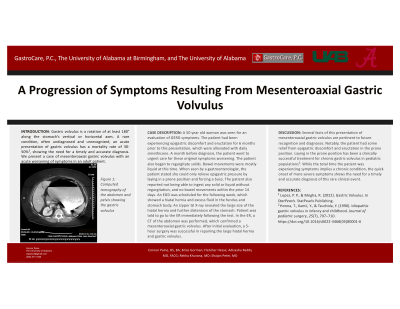Sunday Poster Session
Category: Stomach
P1633 - A Progression of Symptoms Resulting From Mesenteroaxial Gastric Volvulus
Sunday, October 27, 2024
3:30 PM - 7:00 PM ET
Location: Exhibit Hall E

Has Audio

Connor Paine, BS, BA
University of Alabama
Tuscaloosa, AL
Presenting Author(s)
Connor Paine, BS, BA1, Brice Gorman, 1, Fletcher Hesse, 1, Adisesha Reddy, MD, FACG2, Rekha Khurana, MD2, Shajan Peter, MD3
1University of Alabama, Tuscaloosa, AL; 2GastroCare P.C., Tuscaloosa, AL; 3Basil I. Hirschowitz Endoscopic Center of Excellence, The University of Alabama at Birmingham Heersink School of Medicine, Birmingham, AL
Introduction: Gastric volvulus is a rotation of at least 180° along the stomach’s vertical or horizontal axes. A rare condition, often undiagnosed and unrecognized, an acute presentation of gastric volvulus has a mortality rate of 30-50%1, showing the need for a timely and accurate diagnosis. We present a case of mesenteroaxial gastric volvulus with an acute worsening of symptoms in an adult patient.
Case Description/Methods: A 50 year old woman was seen for an evaluation of GERD symptoms. The patient had been experiencing epigastric discomfort and eructation for 6 months prior to this presentation, which were alleviated with daily simethicone. A month before diagnosis, the patient went to urgent care for these original symptoms worsening. The patient also began to regurgitate solids. Bowel movements were mostly liquid at this time. When seen by a gastroenterologist, the patient stated she could only relieve epigastric pressure by laying in a prone position and forcing a burp. The patient also reported not being able to ingest any solid or liquid without regurgitation, and no bowel movements within the prior 14 days. An EGD was scheduled for the following week, which showed a hiatal hernia and excess fluid in the fundus and stomach body. An Upper GI X-ray revealed the large size of the hiatal hernia and further distension of the stomach. Patient was told to go to the ER immediately following the test. In the ER, a CT of the abdomen was performed, which confirmed a mesenteroaxial gastric volvulus. After initial evaluation, a 5-hour surgery was successful in repairing the large hiatal hernia and gastric volvulus.
Discussion: Several facts of this presentation of mesenteroaxial gastric volvulus are pertinent to future recognition and diagnoses. Notably, the patient had some relief from epigastric discomfort and eructation in the prone position. Laying in the prone position has been a clinically successful treatment for chronic gastric volvulus in pediatric populations2. While the total time the patient was experiencing symptoms implies a chronic condition, the quick onset of more severe symptoms shows the need for an accurate and timely diagnosis of this rare clinical event.
1 Lopez, P. P., & Megha, R. (2022). Gastric Volvulus. In StatPearls. StatPearls Publishing.
2 Honna, T., Kamii, Y., & Tsuchida, Y. (1990). Idiopathic gastric volvulus in infancy and childhood. Journal of pediatric surgery, 25(7), 707–710. https://doi.org/10.1016/s0022-3468(05)80001-6
Disclosures:
Connor Paine, BS, BA1, Brice Gorman, 1, Fletcher Hesse, 1, Adisesha Reddy, MD, FACG2, Rekha Khurana, MD2, Shajan Peter, MD3. P1633 - A Progression of Symptoms Resulting From Mesenteroaxial Gastric Volvulus, ACG 2024 Annual Scientific Meeting Abstracts. Philadelphia, PA: American College of Gastroenterology.
1University of Alabama, Tuscaloosa, AL; 2GastroCare P.C., Tuscaloosa, AL; 3Basil I. Hirschowitz Endoscopic Center of Excellence, The University of Alabama at Birmingham Heersink School of Medicine, Birmingham, AL
Introduction: Gastric volvulus is a rotation of at least 180° along the stomach’s vertical or horizontal axes. A rare condition, often undiagnosed and unrecognized, an acute presentation of gastric volvulus has a mortality rate of 30-50%1, showing the need for a timely and accurate diagnosis. We present a case of mesenteroaxial gastric volvulus with an acute worsening of symptoms in an adult patient.
Case Description/Methods: A 50 year old woman was seen for an evaluation of GERD symptoms. The patient had been experiencing epigastric discomfort and eructation for 6 months prior to this presentation, which were alleviated with daily simethicone. A month before diagnosis, the patient went to urgent care for these original symptoms worsening. The patient also began to regurgitate solids. Bowel movements were mostly liquid at this time. When seen by a gastroenterologist, the patient stated she could only relieve epigastric pressure by laying in a prone position and forcing a burp. The patient also reported not being able to ingest any solid or liquid without regurgitation, and no bowel movements within the prior 14 days. An EGD was scheduled for the following week, which showed a hiatal hernia and excess fluid in the fundus and stomach body. An Upper GI X-ray revealed the large size of the hiatal hernia and further distension of the stomach. Patient was told to go to the ER immediately following the test. In the ER, a CT of the abdomen was performed, which confirmed a mesenteroaxial gastric volvulus. After initial evaluation, a 5-hour surgery was successful in repairing the large hiatal hernia and gastric volvulus.
Discussion: Several facts of this presentation of mesenteroaxial gastric volvulus are pertinent to future recognition and diagnoses. Notably, the patient had some relief from epigastric discomfort and eructation in the prone position. Laying in the prone position has been a clinically successful treatment for chronic gastric volvulus in pediatric populations2. While the total time the patient was experiencing symptoms implies a chronic condition, the quick onset of more severe symptoms shows the need for an accurate and timely diagnosis of this rare clinical event.
1 Lopez, P. P., & Megha, R. (2022). Gastric Volvulus. In StatPearls. StatPearls Publishing.
2 Honna, T., Kamii, Y., & Tsuchida, Y. (1990). Idiopathic gastric volvulus in infancy and childhood. Journal of pediatric surgery, 25(7), 707–710. https://doi.org/10.1016/s0022-3468(05)80001-6
Disclosures:
Connor Paine indicated no relevant financial relationships.
Brice Gorman indicated no relevant financial relationships.
Fletcher Hesse indicated no relevant financial relationships.
Adisesha Reddy indicated no relevant financial relationships.
Rekha Khurana indicated no relevant financial relationships.
Shajan Peter: Olympus – Consultant.
Connor Paine, BS, BA1, Brice Gorman, 1, Fletcher Hesse, 1, Adisesha Reddy, MD, FACG2, Rekha Khurana, MD2, Shajan Peter, MD3. P1633 - A Progression of Symptoms Resulting From Mesenteroaxial Gastric Volvulus, ACG 2024 Annual Scientific Meeting Abstracts. Philadelphia, PA: American College of Gastroenterology.
